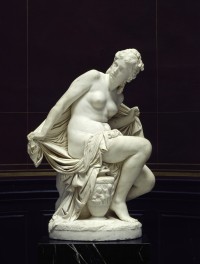The Staatliche Museen zu Berlin has restituted a statue stolen by Nazis to the heirs of Felicia Lachmann-Mosse. You might recall Felicia, daughter of German Jewish publisher, philanthropist and collector of art and antiquities Rudolf Mosse, and the foundation representing her heirs from the recent article about the beautiful mummy portraits restituted to the family by the University of Zurich. Rudolf Mosse had been dead for more than a decade when the Nazis came to power in 1933, but his flagship newspaper the Berliner Tageblatt was still very much in print and very much opposed to National Socialism. Felicia and her husband Hans Lachmann Mosse tried to accomodate the new overlords by flipping the newspaper’s political orientation to the far right, but they soon realized that would not appease the Nazis. They fled to France through Switzerland and eventually made it to the United States.
The great Mosse collection had to be left behind. The Nazi government confiscated the Mosse publishing company, all of its newspapers, the Mosse family’s real estate and the collection. Nazi officials helped themselves to what they wanted and put the rest up for auction. Records of the art and artifacts stolen from the collection before the public auction are sketchy to non-existent. The Mosse Art Restitution Project was set up by the family in 2012 to track down and document the objects stolen from the Mosse collection and scattered during World War II and its aftermath.
 A significant number of Mosse artworks made their way to the Staatliche Museen. In 2015 alone, the Prussian Cultural Heritage Foundation restituted eight works — including a Roman sarcophagus, a 1903 Reclining Lion sculpted by August Gaul, two ancient Egyptian vessels, two 19th century Chinese lions — from the Staatliche to the heirs of Felicia Lachmann-Mosse after a systematic review of their holdings and a request for information on two of the pieces from the Mosse Art Restitution Project. This year, the restituted work is a sculpture of Susanna by Reinhold Begas, made between 1869-72.
A significant number of Mosse artworks made their way to the Staatliche Museen. In 2015 alone, the Prussian Cultural Heritage Foundation restituted eight works — including a Roman sarcophagus, a 1903 Reclining Lion sculpted by August Gaul, two ancient Egyptian vessels, two 19th century Chinese lions — from the Staatliche to the heirs of Felicia Lachmann-Mosse after a systematic review of their holdings and a request for information on two of the pieces from the Mosse Art Restitution Project. This year, the restituted work is a sculpture of Susanna by Reinhold Begas, made between 1869-72.
Born in 1831 the son of painter Carl Joseph Begas, Reinhold Begas began to study sculpture when he was a boy. He’d already had extensive training when he at the age of 15 he became a student of Christian Daniel Rauch at the Prussian Academy of Arts in Berlin. Two years later Rauch hired him to sculpt in his workshop. Four years after that he had his first notable success with a plaster Hagar and Ishmael group in the 1852 Academy exhibition. This garnered him a scholarship and the opportunity to study in Rome.
Over the next decade he taught art in Weimar, had extended stays in Berlin, Rome and Paris, developing a naturalistic style with realistic emotion that would come to characterize the neo-baroque Berlin school of sculpture. He received many commissions for portrait busts, mythological scenes, memorials, tombs, national monuments and fountains and became a favorite of Kaiser Wilhelm II.
How Begas’ Susanna got to the Staatliche is unclear. When it was published in a 1999 catalogue of artworks lost during the war, the only information available was that it had presumably been pillaged from Berlin by the Soviets in 1946 and was returned to Museum für Völkerkunde in Leipzig in 1956 or 1958. It was given to the Old National Gallery of the Staatliche Museen in 1994 and went on permanent display there when the gallery reopened in 2001.
For the time being, it will remain on display with other paintings and sculptures from prominent 19th century artists on the first floor of the Old National Gallery. Its ownership status has changed, but for now the Mosse heirs have agreed to loan it back to the museum.
I had to look up “Susanna.” Her story, in the Book of Daniel, offers “the possibilities […]for a prominent nude female in a history painting – paintings of Bathsheba bathing offered an alternative subject with the same advantages.” [source: Wikipedia]
Dottir, unless the ladies were pagan or savages, a useful narrative was key:
————–
artist: “Do you have nude paintings of your wife ?”
count: “WHAT! – You do you think you are ?”
artist: “They are worth the money and all look like Susanna”
:hattip:
PP: 😆